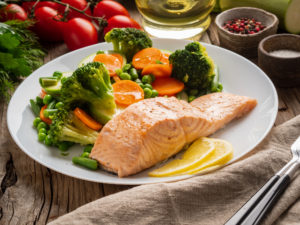 Food choices can fight or promote inflammation. And although reaching for a pill may help quell a headache or arthritic flare-up, they won’t do the job in preventing heart disease, type-2 diabetes, or future flare-ups.
Food choices can fight or promote inflammation. And although reaching for a pill may help quell a headache or arthritic flare-up, they won’t do the job in preventing heart disease, type-2 diabetes, or future flare-ups.
To get those anti-inflammatory benefits, your best bet might be an anti-inflammatory diet.
Advertisement
Chronic low-grade inflammation is associated with a host of chronic medical conditions including heart disease, type-2 diabetes, rheumatoid arthritis, and dementia. Plenty of research has shown diet contributes to these illnesses and food is a leading source of inflammation.
By now, you’re likely aware of the culprits: processed foods, refined grains, sugary beverages, trans-fat, processed meat, fast food, and certain cooking oils and margarine.
On the other hand, you probably know that minimally or unprocessed nutrients and antioxidant-rich foods can limit inflammation and reduce the risk of chronic illness.
But how do you translate that information into your life? By keeping these things in mind:
- Focus on building meals using fresh and simple ingredients.
- Make colorful fruits and vegetables prominent in meals and as snacks (leafy greens, tomato, berries, apples, etc.).
- Replace refined “snack foods” with nuts, fruits, seeds, and vegetables.
- Try including fatty fish like salmon or ahi tuna into your meal plan at least two nights per week.
- Select whole-grain versions of bread and pasta over refined “white” options.
- Avoid sugary beverages like soda, sweet tea, “specialty” coffee drinks, etc. Supplement them with sparkling water, carbonated water, unsweetened tea, and coffee.
- Find ways to supplement beans and legumes into meals, on occasion. Legumes like these can be used in burgers, chili, and more.
- Avoid cooking with butter, margarine, soybean, vegetables, or coconut oil. Instead, use olive oil. Using olive oil as salad dressing is also recommended.
- Try to eat as many colors of food (naturally) as possible. Berries, cherries, apples, broccoli, kale, oranges, etc.
- Read ingredient labels carefully and minimize the intake of food with long ingredient lists, and those featuring words like “high fructose corn syrup, sugar, hydrogenated, or any word ending in -ose”
Healthy fats, fruits and vegetables, nuts, seeds, legumes, whole grains, and unprocessed meat should be the centerpieces of the anti-inflammatory diet. These items can reduce inflammation and lower the risk of a host of common chronic illnesses.
This practical guide can help protect your health by silencing systemic inflammation.
